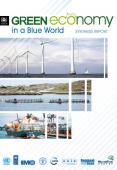This report was commissioned by UNEP in response to the multiple global crises of 2008 – fuel, food and financial. The report proposes a mix of policy actions that would stimulate economic recovery and at the same time improve the sustainability of the world economy. The Global Green New Deal (GGND) calls on governments to allocate a significant share of stimulus funding to green sectors and sets out three objectives: (i) economic recovery; (ii) poverty eradication; and (iii) reduced carbon emissions and ecosystem degradation; and proposed a framework for green stimulus programs as well as supportive domestic and international policies.
National actions proposed for the GGND include:
Launched at Global Roundtable on 19-20 October 2011 in Washington DC, the UNEP FI Guide to Banking and Sustainability provides a clause-by-clause explanation of the UNEP Statement of Commitment by Financial Institutions on Sustainable Development, seeking both to shed further light on the meaning of individual clauses, and to provide guidance on how banking institutions might seek to apply them in their day-to-day operations. The Guide further provides illustrations of current practice within UNEP FI Signatory banks, and references to key resources.
The tool results from consultations with a variety of UNEP FI members from the banking sector, who have identified a range of uses to the Guide, from Board level to operations:

This report investigates the current levels of investment in green economic initiatives and infrastructure in Jordan. The report also defines the economic, social and environmental challenges faced by Jordan and identifies the sectors that present the greatest opportunities for further investment to drive the transition to a green economy. The report identifies sectors that include energy, water, transport, waste management, agriculture and tourism.
This summary was prepared by the Division for Sustainable Development, UNDESA.
Approximately two million Americans are employed in sectors such as water management, agriculture, and disaster preparedness and response that contribute to building resilience to the impacts of climate change. Through investments in climate change resilience, we can proactively reduce the impact of natural disasters and drive economic growth. By spurring the development and deployment of new technologies and strategies such as efficient irrigation systems and early flood and storm warning systems we can save lives in the poor communities most vulnerable to climate change—and create jobs in the process.
This publication is the Synthesis for Policy Makers of UNEP's Green Economy Report. Compiled by UNEP’s Green Economy Initiative in collaboration with economists and experts worldwide, the report demonstrates that the greening of economies is not generally a drag on growth but rather a new engine of growth; that it is a net generator of decent jobs, and that it is also a vital strategy for the elimination of persistent poverty. The report also seeks to motivate policy makers to create the enabling conditions for increased investments in a transition to a green economy.

This paper explores in more detail the sustainability and economic challenges and opportunities of industrial development. In keeping with UNIDO’s mandate, the focus is on industry in the developing countries. How can enterprises in these countries become greener and lessen their environmental footprint while at the same time continuing to grow and deliver goods, services and jobs to their populations? What role should the governments of developing countries play in this process? Answers to these questions must take into account one overriding imperative: that industry in developing countries needs to grow. Industrial development is the only mechanism that will enable developing countries to reduce the level of poverty and hardship they face. The conclusion offers a strategy for the development aid community, designed to help developing countries bridge the gap between the present and the future.
Chemical leasing is a service-oriented business model that shifts the focus from increasing sales volume of chemicals toward a value-added approach. Chemical leasing forms part of UNIDO’s strategy to assist enterprises globally in a variety of aspects related to green industry. Over the past few years, this innovative approach has been implemented in a number of different sectors, processes and countries. Experience has shown that it is best applied to processes that are not the core know-how of the chemical user, such as cleaning, degreasing and painting, etc. In 2005, UNIDO launched the Global Chemical Leasing Programme, which is presently supported by the Governments of Austria and Germany. At the national level, it is implemented in close cooperation with respective National Cleaner Production Centres (NCPCs).
